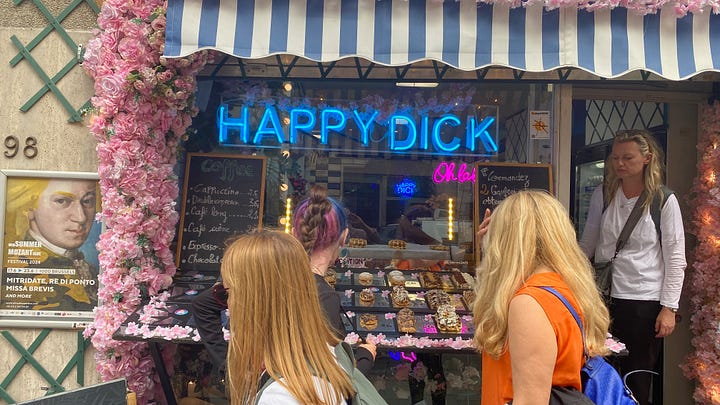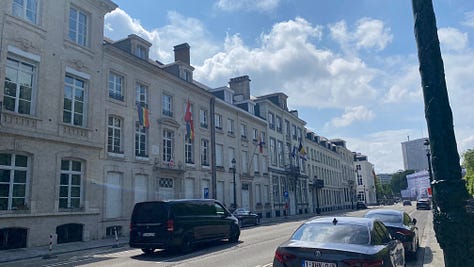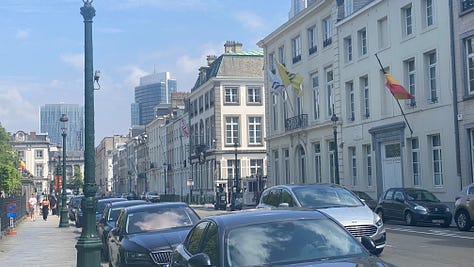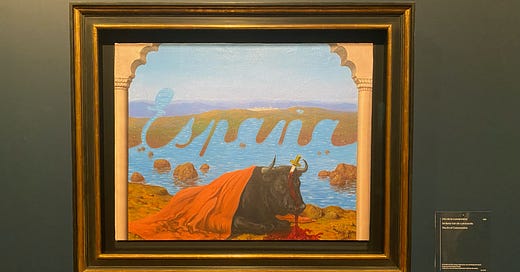Let's hustle off to Brussels
Capital of the EU in all but name, this Belgian city offers visitors plenty to see, eat and drink. And no, not just fries, beer, waffles and chocolate.
Little cabbages, a little man, big politics. These are probably the things most association with Brussels, the capital of Belgium and the object of my three-day visit in late May.
We will skip the discussion of Brussels sprouts, which put the city name on plates of unhappy children all over the world. You won’t find it on any tourist map in any case, there are no tours of Brussels sprout farms or restaurants specializing in the green cuisine. Nope, if you’re going to talk food in Belgium, it’s all about the chocolate, the waffles, the fries and the beer, sometimes served together.


Belgians also have an irreverent sense of humour about their food. As you can see from one of the first pastry shops I encountered while visiting the old quarter around La Grand Place. Although I arrived in Brussels just as the city’s Gay Pride activities were winding down, the Happy Dick is a year-round patisserie, not far from the statue of Brussels’ most famous citizen, the Manneken Pis.



There is no better icon of “Belgitude” than Manneken Pis, which translates to the Little Pissing Man. The 55.5-centimetre-tall bronze statue isn’t always naked, as he is in the video, either. In fact, he has over 1,000 costumes on display in the nearby Manneken Pis museum, whose window is a little hard to photograph due to glare, as you can see in my ghostly image in the above gallery. He is also one of the city’s most famous attractions. A little too famous, perhaps. The statue has been stolen at least seven times, dismembered at least once, and is now safely stored in a museum while a replica urinates for a constant, ahem, stream of visitors.
Which brings us to the third thing for which the Belgian capital is famous, it’s role as the main seat of the European Union. Tho it’s not legally considered the EU capital, it is the host of many of the union’s commissions and institutions including the executive Council, and when the EU Parliament is in session, it convenes there three weeks per month vs one week in Strasbourg.
I managed to arrive in Brussels on a long weekend, so the Parliament was closed, as was the Parlamentarium visitor’s centre. So much as I was looking forward to watching people argue, I had to settle for the House of European History on the beautiful Parc Léopold. The museum takes you through the political and socio-economic evolution of Europe, which is a seemingly never-ending kaleidoscope of shifting conquests, from pre-Roman civilizations to present day.
One of the exhibits that really struck me, however, was an animated map that showed the shift of numerous European nations from democracies to authoritarian or fascist governments from the 1920s right up until the Second World War. It reminded me that the hard right, authoritarian shift we are seeing now in countries like Hungary, Italy, Finland, Slovakia, Croatia, the Netherlands and the Czech Republic is not unprecedented, and that millions of lives were lost before the tide was turned. Institutions like the UN and the EU were supposed to be our way to peacefully resolve competing interests for the good of all, to encourage international cooperation over nationalistic self-interest. For all their flaws, tho, there’s one thing that’s certain: we are better protected now than if they did not exist.




Okay, I’m done with glum. How about a little surrealism?
You can’t visit Brussels without checking out the exhibition of more than 230 works by famed Belgian artist, pioneer surrealist and sometimes forger, René Magritte. The Magritte Museum is located in the Hôtel du Lotto, a 5-storey 18-century mansion that is part of the Royal Museums of Fine Arts of Belgium. With each floor you advance your chronological exploration of his extensive work, including paintings, gouaches, drawings, sculptures, painted objects, films, musical scores, photographs and advertising posters. I confess I didn’t recognize Magritte’s name when I entered the exhibition, but the images were instantly familiar and the works on display and audio guide were both entertaining and illuminating.





Brussels is a city that also offers some impressive architecture, both ancient and modern. The mix is eclectic without being jarring, the old and new blending in ways that are not quite seamless, but which seem to reinforce each other.






I took a free walking tour, as is my habit, starting from the central Grand Place and working our way to the relatively new Royal Palace, built at the end of the 18th century (but closed for renovations!!). Exploring on my own a little later, I noticed that many of the embassies were flying rainbow flags in solidarity with the LGBTQ2 communities. The Canadian embassy was among the most prominent, but one big exception was the U.S. embassy, were I was told by armed guards that taking photos of the outside of the building was forbidden! (Tho you can find lots of photos of it by Googling). Those Yanks can be weird.






Okay, I have a lot more I could say about Brussels but I try to keep these things from being too long. I’ll just wrap up by saying that the Belgian capital is vibrant and cosmopolitan, with plenty of attractions both visual and culinary.
And if you’re wondering about the beer and chocolate, well, you’ll have to discover that for yourself, since I don’t drink alcohol and rarely eat chocolate. Yes, I know, it’s a shame. But for your sake, I did check out the fries and waffles and can confirm they are magnifique!



See you farther down the road! Next stop, Ghent!






